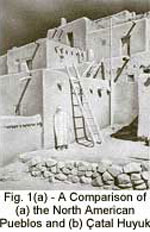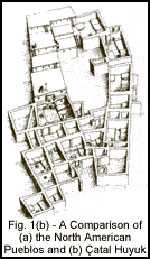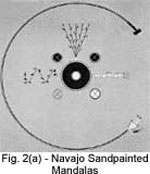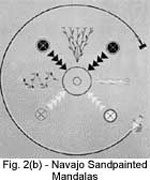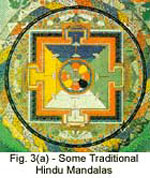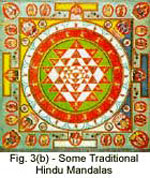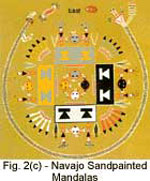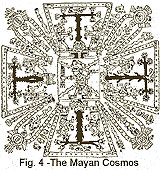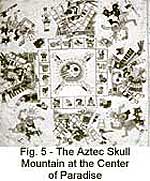|
by Arysio Nunes dos Santos Written prior to 1999 from Atlan Website
Introduction
They comprise about 100,000 individuals,
and inhabit New Mexico, Arizona and Utah. The Navajo Indians are
close of kin to the Apaches and were, as these, deeply influenced by
the more civilized, agrarian Pueblo Indians. Under this influence,
the Navajos adopted a sedentary existence, based on agriculture and,
later, in the herding of goats, sheep and cattle.
Moreover, we interpret
this myth in detail, showing that it is indeed an allegorical
exposition of the myth of Paradise and its secret whereabouts. This
Paradise is no other thing than Eden or Atlantis, the original
homeland of Mankind and Civilization, as will become clear from the
present discussion.
With this
the Conquistadores and the Bandeirantes - as well as their
counterparts elsewhere - were justified in plundering the land and
the possessions of the natives, as they did, and in enslaving them.
Of course, this missionary and civilizatory influence would not be needed if the natives partook of the very same Tradition, the Primordial Religion and culture that came to us from Paradise, brought by the angels themselves, in the dawn of times.
So, the
modern anthropologists who cling to this view are but the legitimate
heirs of this ancient tradition, which they defend irrationally,
despite all sorts of compelling contrary evidence.
Like most Amerindian
nations, they claim to have come from a subterranean world through
caves or vents that connect with this upper world. Theirs is a
Mystery Religion based on Drug Cults (Peyotism), on shamanism, and
on amuletic songs, dances, design and rituals.
As a matter of
fact, this conception of a subterranean Paradise whence Mankind
sprung into the present era coming from a former one was also
widespread in the Ancient World as well. For instance, Civilizing
Heroes such as Osiris, Serapis,
Mithras
and several others originally rose from a cave or a subterranean
abode, more or less in the way that Christ too rose from among the
dead.
Again, the Polynesians also claim to have come originally from a sunken island or continent which they called by names such as Hawaiki (or Javaiki), which mean something like "Sunken Grove", that is, the same as the sunken Garden of Eden.
And, as we argue elsewhere,
the Polynesian Paradise, just as all others indeed lay in the
submerged portion of primordial Indonesia.
In one, the Ancestors fall down from Heaven
above, and civilize the semi-bestial humans, with whom they breed
the new humanity. In the other, as with the Amerinds, the Ancestors
come from the Netherworld, and effect what amounts to a second
Creation which is in all respects the dual of the former one.
The god of Gen.1, Elohim is clearly Celestial. But the one of Gen.2, Jahveh, starts his Creation from below, as "the mist that came up from under the earth".
In other words, the spirit ("mist") of God ascends from below, together with the subterranean waters and, certainly, followed by his hosts (or people), much in the manner of the Indians.
The archetype of the Earth Diver is Vishnu, in
his Boar avatar (Varaha). The one of the Fallen Sun is, again,
derived from a Hindu archetype; that of Vishvasvat,
the Sun, and his many aliases. Both of these Cosmogonic motifs date
from Vedic times in India, and there can be no question of Hindu
precedence.
This diffusion of civilization
can be traced further back to the Incas of Peru and, across the
Pacific Ocean, all the way to Indonesia and to India.
The pueblos are, like their Old World
counterparts, a sort of human "beehive" in which the individual
apartments form "cells" destitute of doors and windows.
Burial methods, the advanced agriculture, bull-worship and the cult
of the Great Mother, and several other similarities further testify
to an ancient connection among these distant sites.
Zuñi mythology
depicts their ancestors actually emerging from the underground mud in
Paradise and immigrating to their present location.
And these are, as we argue elsewhere, the same as the Seven Islands of the Blest, which are no other than the sunken Eden of the Judeo-Christians.
The name of the Golden Cities of Cibola very obviously came from the Dravida civ-pola, meaning "golden city" or, yet, "city of the reds".
t is
interesting to note that "Reds" or "Golden" are usual epithets of
the Atlanteans. Adam too was a "Red", that is, a
Chamite, as his name (means "red") unequivocally indicates.
In fact, the number alludes to the seven great islands of Indonesia: Java, Sumatra, Borneo, Celebes, Philippines, New Guinea and the Malay Peninsula, which the ancients counted as an island.
We recall that the fundamental rule of the science of symbolism is that a symbol or a convention cannot be invoked to explain the origin of another symbol, for this just transfers the problem.
So, the sacredness of the number seven - the holiest number of the Hindus - can only derive from their seven Dvipas or Paradises, that is, from precisely the above islands.
Can you think of another sacred seven that is not purely conventional in origin?
The Spaniards mistook the Americas - which they later called West Indies - for the East Indies, which they knew to be the site of Paradise and, hence, of the fabled Seven Golden Cities of Cibola. Cibola, "the Golden City", is just one of the many names of Lemurian Atlantis.
The name of "Seven Golden Cities" or "Seven Golden Islands" was applied by the ancients to the Indonesian islands, and to no other place.
This name is indeed a translation of the Sanskrit Suvarna-dvipa, which gave the Greek Chryse Chersonesos and the Latin
Aurea Chersonesus, all meaning the same thing as "Golden City" or
"Golden Island".
This is another evidence of their cult of the Great Mother, which is a feature of Dravidian Hinduism. The Navajo rites, chants and dances are based entirely on the characters, incidents and places of their mythology and ritual designs.
The dancers wear masks and dresses according to
exacting standards, and impersonate the gods and heroes (Kachina) of
their mythology.
Indeed, the Navajo Twins are the counterparts of those of the Old World, pairs like Castor and Pollux, Atlas and Gadeiros, as well as the Ashvin Twins of Vedic India. In all cases the function of these Twins was ridding the world of monsters and pests, including diseases and vermin.
This is true on both sides of the world. Hence, it is naive
to think that such perfect correspondences can be the result of
chancy coincidences.
However, as is so often the case with the oppressed races, the Indians disguise their true religion under a heavy veil of allegories and symbolisms that have to be deciphered before the underlying unity and purpose become evident.
Even in this regards,
the religion of the Amerindians closely parallels the Mystery
Religions of the Old World, whose secret contents was never divulged
to the profanes, particularly if these belong to the despicable
white races.
For
instance, the Pueblo Indians disguised their Twins,
during Spanish dominion, under the characters of Djos
and Ley. These two are characters akin to the
Trickster, and figure in vulgar tales tending to the fescenine.
These two types correspond to the
powers the Hindu impersonated in Mitra and Varuna, as so amply
discussed by Prof. G. Dumézil. Mitra ("twin") is the Solar Twin, and
personifies Royalty (Ley), much as Varuna is the Lunar Twin who
corresponds to Magic and Religion (Djos).
The Twins are often likened to the Sun (or Sky) and the
Earth (or Hell), which are esteemed to be their parents.
But in many
other South American nations, the male (or androgynous) character of
the Twins is preserved, with one of them dominant, and the other one
dominated and effeminate.
And when one thinks even harder, it is easy
to see that this origin can only have been in the Indies, whence we
all came from, in the dawn of times.
These names are shared by the other Athabascan-speaking peoples. The
enemy gods are the monsters that inhabited primordial earth, and
which rendered it unfit for human occupation before they were
exterminated by the Twins.
These two should be compared to the Twin War Gods of the
Pueblo Indians, as commented above.
In certain
versions, this Paradise was reached by a man who went down the
Colorado River inside a hollow log. This myth can be understood in
the light of similar South American Indian myths.
But an in depth study of south American mythology
clearly shows a fundamental identity with that of their northern
brothers, particularly insofar as the myths of origin are concerned.
They thus attempted to reach the Center of the Earth
where their god, Wiyot, had hidden himself after he
died. Wiyot was the first of all men to die, and his death taught
his people the example. In fact, Wiyot later resurrected as the New
Moon, and became immortal.
Indeed, the stories of both Wiyot and Yama anticipate that of Christ, who died and resurrected in order to teach his worshippers that it can be done in practice. The death and resurrection of Wiyot is an instance of those of the so-called Vegetation Gods of the Old World.
To this famous confrary also belong gods and
heroes such as Tammuz, Attis, Adonis, Agdistis,
King Arthur, Hercules, and, of course,
Jesus Christ, Osiris and Dionysos.
Apparently, victims and oppressors also change places. As one philosophical Indian once said,
Even before the Portuguese
arrived here, they knew their world was doomed. So, they started
migrating to the coast, awaiting for the Saviour that would lead
them safely across the Ocean, just as Moses, Christ, and other such
Tirthankaras ("Ford-makers" or, rather, "Saviours") had done
in Primordial times.
More or less as happened in
North America, except that in a far larger scale, for the
genocide there was conducted by the government itself.
And this they invariably do, just
as their New World counterparts, by crossing into the Indies, as we
can read in the ancient sagas.
Thus deprived of their
values, the acculturated Indians became an easy prey of the far
more bestial Conquistadores and Bandeirantes who inevitably
follow
the missionaries everywhere they show up among the
primitives.
Once their culture and their religion and social structure are disrupted, send in the colonists to take away their land, their property and even their very humanity, through enslavement and sheer genocide.
Look into History, and
you will see that this sad reality is the rule rather than the
exception everywhere in this world of ours.
These are based on hallucinogens such as the sacred
mushroom, the peyote and the mescal. Indeed, most Indians use one
type or another of drug-induced ecstasy, in order to enhance their
mystical union with God.
A recent study
of several Egyptian mummies by the meticulous Germans unmistakenly
revealed that the Egyptian pharaohs routinely used drugs such as
hemp, opium, tobacco and coca.
In the US, Peyote is eaten in a communal meal that closely resembles the Holy Communion of the Christians, which it apparently parallels. Indeed, modern Peyote religion actually claims that Christ instituted the "White Communion" to Whites and the Peyote (or "Red") Communion to the Reds.
Interestingly enough, the ancient Hindus also
spoke of two similar types of Soma Communion, one "red" (or "golden"
or "Solar"), and the other "white" (or "silvery" or "Lunar").
As recently as the late 1960s, Peyotism was still outlawed in
several regions of the United States of America.
More exactly, Peyotl is the Third Coming of the Saviour so ardently expected by the Gnostics and the Mystics everywhere.
When he comes, shortly, he shall bring the Celestial Bread to all
humans, the white one to the Whites, and the red one to the Reds, in
fair, equal shares to all of us humans.
1
And her name refers to
the idea that our planet periodically sloughs off its old skin (the
crust) like a serpent, being reborn as fresh and virginal as a young
bride. This motif is ritually enacted in Navajo dances and chants of
an initiatic character.
Shri was
born, exactly like Aphrodite-Venus, from the froth engendered at the
occasion of the Churning of the Ocean of Milk, in consequence of the
dispute between the gods an the devils (devas and asuras) for
possession of the Elixir of Life, the Soma.
This event is also allegorized, again in beautiful images, the
Primordial Castration of the Holy Mountain of Paradise and its fall
into the Ocean, and the rebirth of the renewed Paradise of the
subsequent era.
The former Sun (male) falls down into the seas, and is reborn as the New Moon (female) that is the alias of Venus or, yet, of the renewed Earth and the rejuvenated Great Mother that is her daughter, the Virgin.
Interestingly enough, the birth of the Twins
is also attended by foam which, as we will see below, has a deep
esoteric significance.
A well-known case
is that of Hercules and Iphicles, successively fathered by Zeus and
Amphitrion.
Several apocryphal gospels tell, often in allegoric but unequivocal terms, of the dual paternity of Christ and his many-named Twin.
The two fathers are either Joseph and the Angel,
the Holy Ghost and the Father or even Joseph and a mysterious
Roman legionary called Panthera.
Apparently, she is reborn as a male, the Junior Twin or as his twin sister, the Virgin. Junior is far more than just a companion and mate to the Elder Twin. He/she also seems to be his lover as well.
This is evidenced, for instance, when Changing Woman completes the change, and sings:
Amphion was
rough and brutal and gigantic like Slayer-of-alien-gods, whereas
Zethos was slight, gentle and charming like Child-of-the-waters. The
elder twin was born "somewhat precipitately, to the sound of
thunder", whereas the younger one was born "mildly to the
accompaniment of gentle thunder".
There, the twins are
called Nanderikey and Tiviry by the Apapocuva Guarani,
names that mean, respectively "Our Lord" and "Twin". The Twins are
also worshipped by the other South American Indians, who call them
by equivalent names.
Both gods end up by being castrated, like Romi Kumu and Jurupari.
This event takes place repeatedly in different occasions, during
which, in alternation, one of the Twins plays the female to the
other Twin. In this way they engender Humanity and, indeed the whole
of Creation.
The figure of Christ’s twin is often the one of the Beloved Disciple. This personage is often confused with St. John the Baptist, with St. John the Evangelist, with Thomas Dydimus ("twin Twin") or even Judas and Mary the Magdalene.
For
instance, in Gnostic figurations such as the famous one of
Leonardo da Vinci, St. John the Baptist is traditionally painted
as an androgynous personage, charming and effeminate.
Even the puzzling detail which the Hindus call samkarshana - the mysterious trading of wombs from one Virgin Mother to the other - is not lacking in the Christian version. Actually, these mysterious events are allegories of the Paradisial events having to do with the Mass (Missa) and the Messias, as discussed in the previous footnote.
But this theme cannot be treated
in more detail here, for certain things may not yet be disclosed.
They were reared by the doorkeepers of Changing
Woman, Bear Man and Rattlesnake Man. These two doorkeepers
apparently correspond to the Polar Constellations of the Lesser Bear
and
Draco, whereas Changing Woman herself corresponds to
Lyra, the third Polar Constellation, which is the female
counterpart of the other two, both males.
This is a complex subject, whose discussion does not fit
here, and which has been examined by us elsewhere. It has to do with
the alternation of the Eras of Mankind and the sharing of the single
phallus between the two deities, who trade roles and sex this way.
All such, are indeed personifications of nations, races and peoples that fashioned human history and are considered to be our mythical Ancestors.
More exactly still, the Twins personify the twin Atlantises, the two Paradises where humanity originally arose and evolved, becoming civilized, and reaching a spiritual and technical development that we are still, despite all our arrogance, incapable of even dreaming about.
When we grow up as
much as they did, we can perhaps become gods and angels, as
Pythagoras said we could.
Soon after their birth
- they grew up in a few days - the Twins set out to search for their
father, the Sun, in order to be granted powers. Their way is long
and difficult, and fraught with dangers posed by all sorts of
monsters and perils, which they conquer.
There they are resisted by the Four Guardians: Bear, Rattlesnake, Wind, and Thunder, who are appeased when they state their respective names. The Sun, at first, fails to acknowledge the Twins as his own children, and attempts to kill them. But after several unsuccessful attempts, the Sun finally recognizes his children in the two valiant boys.
He renders them invisible and immortal, "after his own image",
rendering them "holy forever".
These were capable of killing all sorts of monsters, former children of his own. The Twins then return to earth, falling from the skies "like lightning bolts".
The place where the first twin landed became known as "Like-zigzag-lightning-he-came-down", whereas that of the second twin was named "Let-down-on-a-sunbeam".
These "descents from heaven"
in the shape of lightning bolts are avatars, a Sanskrit word meaning
"falling star" and, more exactly, implying the fall of the vajra.
Next, the Twins set out
again from their mother’s house, leaving behind their own
counterparts in the persons of Holy Man and Holy Boy.
These five mountains are all holy. They closely correspond to Mt. Meru and its four flanking mountains, which are the sites of the Hindu Paradises, as we shall see further below.
As such, the five mountains - which form a
quincunx like the Hindu and the Pythagorean ones —are endlessly
portrayed in the Navajo sandpainted mandalas which we will be discussing further below.
This they give to their mother,
Changing Woman, in order to make her young again. After her change,
Changing Woman is made to move out to a place "near Canyon de Chelly" (the Navajo Indian Reservation in Arizona), forced out of
her pristine home by the Twins and other gods.
For instance the Clashing Rocks are the
same as the Symplegades of the Odyssey and the Argonautica, and also
have counterparts in South America, in the Yvymomó of the Apopocuva
Guaranis, not to mention the other Indians.
In
particular the adventures of the Amerindian Twins closely correspond
to those of Krishna and Balarama of Hindu traditions, of Gilgamesh
and Enkidu of Sumerian myths, or the ones of Horus and Seth in
Egyptian mythology or, yet, those of Atlas (or Orion)
and Hercules in Greece or of Thor and Odin among the Scandinavians.
The dual of the Cosmic Mountain (Linga) is the Cosmic Chasm (Yoni), figured in Homer as the terrifying Charybdis faced by Odysseus in his trip to Phaeacia, which is no other thing than the sunken paradise of Atlantis.
In fact, Scylla and Charybdis - one a giant
volcanic peak, the other the enormous caldera of a submarine volcano
- are allegories of the impassable barrier of the Pillars of
Hercules, as we explain elsewhere in detail.
This legend is connected
with the one of the Sargasso Sea of the ancients
which, allegedly, did the same. Ultimately, the (Phoenician) legend
of the Sea of Sargassos derives from the Hindu one of Nalanala ("Sea
of Weeds") and that of Kushadvipa ("the Island of Kusha Grass"),
whose reeds also retained passing ships and dragged them to the
bottom, just as Columbus and his men feared would happen to
them in the Caribbean region they mistook for the one of the Indies,
which they indeed intended to reach.
And it is indeed in
Indonesia that we find the huge chasm which the Greeks called Symplegades, and which the Hindus call by the name of
Vadava-mukha ("the Mare's Mouth"). The Vadava-mukha is actually the
site of the Krakatoa volcano, which turned into a immense caldera
after the catastrophic explosive eruption that devastated paradisial
Atlantis.
This happens even today, when the local volcanoes, including the Krakatoa itself, erupt explosively, spewing out cinders and volcanic bombs composed of pumice-stone which forms enormous banks that hamper navigation in the local seas.
From the magnitude of the banks of pumice formed by such relatively minor eruptions, we can imagine the huge size of the colossal explosion that razed Paradisial Atlantis.
The Hindu Archetypes
More exactly, they correspond to the Rainbow Nagas of Angkor, which serve a similar purpose or, yet, the well-known Vimanas (or Flying Chariots) of the Hindus.
One such is Pushpaka, the giant airship that transported Rama and his immense armies on their way back from Lanka, the Paradise they had conquered and destroyed in Indonesia.
Lanka is the true
archetype of Atlantis, and it is interesting to find
in that war - the War of Atlantis - the super-weapons such as Pushpaka
and others such mentioned in the beautiful Hindu saga, the Ramayana.
True or fictional, such flying chariots
- called vimanas or vahanas in Sanskrit - permeate Hindu Holy Books such
as the Ramayana and the Mahabharata, and have clearly inspired the
other similar traditions like those of the Celts, the Germans, the
Indonesians and the Navajos.
The thunderbolt is really the vajra, and represents a falling star or, more exactly, a meteoritic fall. We encounter, as we already said, the same motif in the Bible, where both Christ and Lucifer "fall from the skies like lightning".
In Indonesian traditions, illustrated in stone
in the majestic portals of Borobudur, it is the Celestial Nagas that do so, and that serve as the magic
rainbow bridge that links heaven and earth. In Vedic India, it is
the decapitated head of Dadhyanch (or Angiras) that falls from the
skies thus.
And, as
we showed, the avatars of Vishnu are really allegories of such "star-falls"
(ava-taras). Indeed, the fall of Lucifer and even the
descent of Christ down to earth is described, in the Bible, as "similar
to the fall of a thunderbolt", an image obviously gotten from
the Hindu archetypes just mentioned.
In Judeo-Christian traditions, it is the skull of Adam that falls
from the skies thus, and that becomes Mt. Calvary (or Golgotha =
"Skull"), as we explain further below.
Conversely, they also allegorize the huge volcanic
bombs thrown from under the earth into the skies by the giant
volcanic explosions such as that of Mt. Atlas, the
very one which destroyed Paradise.
The gods and heroes of
the Navajos, Pueblos and Apaches are called Kachina.
This word seems to be related to the Dravidian Kattiyam = "clever",
"dexterous", "heroic", which implies the idea of a Hero, that is, of
the male engenderer (Skt. gandha).
Why would our forefathers invent such a myth and build their
religions around them if they were just a lie, an invention of some
sort? Saviors such as Christ, Mani,
Buddha and
Krishna among others, are deemed real, historical
personages.
Hence, we see that, in
fact, the Civilizing Heroes are personifications of the Missae (or
Messias), the Celestial Messengers that came out from Atlantis,
that is, from the sunken Paradise turned into the Land of the Dead
of the ancient traditions.
As we said above, the "indigenism" of the Amerindians was, like their "savagery" and their incorrigible "irreligion", merely a contrivance of the Whites in order to justify the genocide of their elder brothers of America, whose land and wealth they burningly coveted.
These pristine Dravidas were the
Atlantean "Reds", called by precisely that epithet in nearly
all traditions.
Indonesia derives its name from the Greek Indos-nesos, meaning "Indian island". But the word "India" derives,
like the name of Eden, from a Sanskrit radix indh (or endh or edh)
meaning "fire".
Her wonderful "Son" (or "Twin" or "Lover") was the
second Paradise, the Indian Atlantis, built in the Indus
And, if
he bears with us to the end of the present chapter he will, we are
sure, be as fully convinced as we were ourselves when we first
discovered the true meaning of Hindu and Amerindian mythology and
their intimate connection with the secret history of Atlantis.
The agreement in form, in detail and in significance transcends all possibility of a random coincidence.
And the forms are so sophisticate, so close in
all details, and so transcendental as to preclude all sorts of
collective archetypes possibly engraved in the human unconscious, in
the way proposed by Jung and Eliade and, a little bit
less fancifully, by
Freud and his school.
In
turn, the Pueblo Indians were instructed by the Mayas and Aztecs;
these by the Incas, and the Incas by the Civilizing Heroes that came
all the way from Indonesia, across Polynesia and Melanesia, as their
own legends and traditions tell in detail.
For reasons of space, we are limited to presenting only a couple of such mandalas.
But the interested reader is recommended to pursue the
Fig. 2 (a and b) shows the Place of Emergence as the Central Mountain surrounded by the Four Subsidiary Centers (also consisting of mountains or islands).
These five mountains are the same as those visited by the Twins, as described further above.
The four piled up triangles at the four corners represent the succession of the Four Eras of Humanity, with the fifth being the central one; the Age of the Heroes of Hesiod, the one which corresponds to Atlantis.
But the motif is also widespread all over the Americas, as we show in other works on the subject.
The staggered triangles of the Navajo mandala represent the same symbolism as those of the famous Shri Yantra mandala of the Hindus.
They represent, as shown in Fig. 3, the sequential Creations of the successive eras emanating like waves from the Primordial Center.
Anyone who pauses to ponder on such exact coincidences
cannot, we believe, come to a different conclusion than that they
indeed originated in India and Indonesia and, more exactly, in
Atlantis and
Lemuria.
One such is a famous fretwork of Hindu origin consisting of a four-pronged star encircled by an octagon. The four-pronged star is indeed a pyramid (Mt. Meru) seen from above, in plant. The four faces of it are indented, like in the Great Pyramid and in that of Mykerinos, so that the pyramid becomes a four-pronged star.
The encircling
octagon represents the circular Oceanus which surrounded
Atlantis. The endless succession of such encircled pyramids
represents the infinite succession of the eras along time.
The
idea is, again, identical to the above one. Other similar decorational motifs are used by the Amazonian and others Indians
from South America in their sieves and other basketry. The colors
they use are usually the ones of the Hindu four varnas
(red, black, white, yellow), obtained by using fibers of different
colors.
And, when we pause to
reflect on their meaning, we see the reason why they are called mandalas or yantras.
In other
words, the mandalas or yantras such as those under discussion are
devices for meditation on the Paradisial events and, more exactly,
on the destruction and sinking of Atlantis by the memorable
explosion of its Holy Mountain.
The Serpentine Rainbow Goddess and the Ouroboros
This Rainbow Snake that encircles
the whole Earth is indeed the Circular Ocean. It is sometimes made
double - as all things are dual. The earth-encircling ocean has its
double (or microcosmic replica) in the River Oceanus that encircled
Atlantis, as well as its many counterparts all over the world.
The Circular Ocean is also shown explicitly in the Hindu mandalas of Fig. 3, one of which is the famous Shri Yantra, in a stylized rendering.
The lotus on top the Holy Mountain of the Hindu mandala of Fig. 3 is indeed the Golden Lotus whose esoteric meaning we examine elsewhere in detail.
The Golden Lotus is indeed the "atomic mushroom" of the giant volcanic explosion that destroyed the site of Paradise and ultimately caused its sinking away.
This
"lotus" is the Pillar of Fire and Smoke that guided the Israelites
on their flight from the site of Sinai, precisely the same mountain
that the Hindus call Meru and the Greeks called Mt. Atlas.
It was, just as in Greece, also the circular river of
Hades which the Greeks equated with the Styx and the Hindus with the
infernal Vaitarani, for sunken Atlantis veritably turned from
Paradise into Hell.
And, in fact, these four colors represent the Four Races of Mankind, which originated in Paradise, at least, according to tradition. The arrangement of the Central (or Whirling) Mountain surrounded by four subsidiary peaks in the Navajo sandpainted mandalas also corresponds to that of Mt. Meru, flanked by its Four Guardians and their corresponding four subsidiary mountain peaks.
In India, as with
the Navajos, the Four Guardians are also represented as
either gods (Lokapalas), mountains, snakes (Nagas) or birds
(Garudas), which are frequent animal shapes assumed by them.
Red is the color of death and bloodshed, representing the warrior caste.
This is symbolically
equivalent to purple or blue, the color associated with death by
asphyxia (drowning, hanging, etc.). This "death" is the drowning of
Atlantis-Paradise turned into Hades, into the Realm of the Dead, by
the cataclysm.
The Four Subsidiary Centers (or
Guardians) are sometimes represented by the Four Trees shown in Fig.
2 or by buffaloes (not shown) or, yet by Winds, Suns, Moons, Bats
(Vampires), Thunderbolts, as well as by Coiled or by Standing
Serpents resembling zigzag lightning and ball lightning.
More exactly, the Lotus allegorizes, as we just said,
the "atomic mushroom" of the colossal explosion of Mt. Atlas, the
one that destroyed Paradise. It was this explosion that drove the
survivors out, and triggered the process of Creation everywhere, in
a worldwide scale.
Mt. Meru is also the Polar (or Whirling)
Mountain, turning at the Center and supporting the skies, just as is
the case with Mt. Atlas, the Pillar of the Skies, in Greek myths.
It was from this hymnary and
the associated Hindu myths that the Greeks copied their traditions
on Atlantis, already old in India and Indonesia when the Greek
nation not even existed as such.
As is clear, the Greeks copied their myths on Atlas
and Atlantis from the Hindu/Indonesian ones, which are not only far
older, but indeed conformal to the local geography and factual
traditions.
What else can
we conclude but that the tradition of Atlantis indeed derives from
the Indies and that it is there that we must search Atlantis-Eden
and the origin of Mankind and Civilization?
These four figures are called Sky
People, and are equated to Dawn, Blue Sky, Yellow Evening Light
(Dusk), and Darkness. These are indeed the Four Cardinal Directions:
Orient (or East), Occident (or West), Noon (or South) and Darkness
(North). More exactly, they correspond to the Four Corners of the
World.
3
This emblem corresponds to the traditional symbol of the
planet Earth, as well as to the so called Cross of Atlantis, as it
corresponds to the shape of the capital city of the empire described
by Plato.
From there the Navajos came, in the
dawn of times, from the Primordial Cave buried under the Holy
Mountain and turned the Realm of the Dead, the Paradisial Hades or
Amenti or Xibalba or such, which the Judeo-Christians later turned
into a hellish Sheol.
This odd shape matching incongruals is also found in the
Indies, for instance, in certain olden pagodas illustrating the
Golden Mountain of Paradise (Mt. Meru), precisely as with the
Whirling Mountain of the Navajo Indians.
This flat-top is also a feature of Mt. Meru (the lotus") and represents the "decapitation of Paradise" that is commemorated in the world’s mythologies.
Sometimes, this central flat-top is represented by an
actual bonfire at the center of the diagram. Alternatively, it is
conventionally represented by a red cross at the exact Center of the
World, that is, at the top of the Whirling Mountain of
Paradise.
The reason for that name derives from the fact
that the Dravidas identified their Supreme God - Shiva Sthanu, the
Pillar of the World - with the Pole Star (Canopus),
which they utilized in their Celestial navigations in Atlantean
times.
The placement of
the Holy Mountain of Paradise - Mt. Atlas or Meru or the Whirling
Mountain, etc. - directly under the Pole Star is, we repeat, a mere
allegory, a purely symbolic representation of its association with
the Tara-milas or Dravidas, and with their great god, the alias of
the Pole Star.
Perhaps his followers, who
obtained the harebrained idea from the late Charles Hapgood,
should also follow the example of their precursors. The serious
reader is urged to discard such a farfetched nonsense, that can only
harm the cause of Atlantis, and bring discredit to it. After all, "you
cannot fool the whole people the whole time", can you?
These were
represented as the Twins of all mythologies and, in particular
the Twins of Navajo traditions. In Egypt, for instance, the
Twin Pole Stars of Atlantean times, Vega and Canopus, were
identified to Hathor and Horus (the Elder), or, also, though more
confusedly, with Isis and Osiris.
These Twins, as those of
the Navajos and other nations, personified the two
primordial, destroyed Paradises, Atlantis and Lemuria.
4
It is also a conventional representation of Mt. Meru as the Hollow Mountain that connects Heaven to Hell below. As in Indian symbolism, we see that the Navajo Sun-god is really Agni, the Principle of Fire, embodied not only in ordinary fire, but in underground fire (volcanic magma). Alternatively, Agni is also represented as Celestial Fire (thunderbolts, meteorites, the Sun).
These three modalities of Fire are the Three Forms of Agni of
Hindu mysticism. They also correspond to Shiva Trikaya
("Three-Bodied") and, in Greek myths, to the three-bodied giant
Geryon, an alias of Atlas.
This Paradise Destroyed turned into a veritable inferno,
plague-ridden and sterile, after it was devastated by the volcanic
explosion far fiercer than the one of the Krakatoa in 1893.
These floating banks of "seafroth"
(pumice) formed the "impassable barrier of slime" (ilus or "froth",
in Greek) mentioned by
Plato as covering the seas of Atlantis and rendering them
inavigable in a more or less permanent way, as we commented above.
There can be no question of coincidence here,
and we are led to conclude that these strange habitations actually
attempted to imitate the Primordial Cave, that is, the volcanic
caldera that linked to the netherworld whence these Indians
allegedly came.
This cave is also the Pacari-Tambo of Mayan traditions, the Cave of Archetypes of Plato's myth, the Cave of Illusions of the Ramayana, and of a hundred similar traditions from all over the world.
And, of course,
this sunken, buried Paradise is no other thing than Atlantis
and, more, exactly Lemuria, its twin and dual.
The typical
tepees of the Plains Indians also resemble volcanoes even more,
being conical in shape with a vent on top to let out the smoke of
the inner fire. By the way, the word hogan came from the Spanish
meaning "stove", and implies an idea of "volcano", just as does the
word "teepee".5
Moreover, its place is often described as immersed in a
perpetual fog and darkness, such as the ones that result from a
volcanic explosion of importance.
The ritual for the construction of figure of this butte is described thus:
In other words, we have an exact miniature of a volcanic peak covered by soot and by enveloping dark smoke.
We can compare the Navajo sandpaintings with the ones from the Mayas, shown in Fig 4 below. This figure is taken from a Mayan Codex. Except for the different style, the conception is exactly the same as that of the Navajo mandala of Fig. 2.
At the four corners, we have the Four Trees of Life, each attended by two Guardians, each having a bird sitting on top, exactly as in certain Navajo sandpaintings.
This warrior is the Sun or, perhaps, his "son", who is indeed his renewed avatar. And the three-pronged vajra (thunderbolt) wielded by the personage is indeed the three-peaked mountain Trikuta, the same as Mt. Meru, the Holy Mountain of Paradise.
In the previous footnote we saw how, in India, the words for "thunderbolt" (ulka) and for "volcano" (ul-kan) are more or less synonymous.
Hence, the thunderbolt-wielding god here portrayed is indeed a personification of the three-peaked, volcanic mountain of Paradise (Trikuta).
Such a visual wordplay - which does not obtain in Amerindian languages
or any others - can only have originated in India. The conclusion is
also that the similar themes in the other mythologies of the world
are also consequently of Hindu origin, unless contrary evidence is
obtained.
This mountain is no other than Mt. Meru or, more exactly, Mt. Kumeru, the Holy Mountain of Paradise.
The name in question is also an exact translation of that of Mt.
Atlas, which is formed of the Greek prefix a meaning "not" and the
radix tla, meaning "to bear out", "to withstand".
6
In turn, the Greek name of Atlas derives directly from the Sanskrit Atala or Atalas, the name of a Hindu sunken Paradise which has
exactly the same signification, and which was the actual archetype
of Atlantis.
The Mayas too have the
Four Guardians (called Bacabs) which they equate to the Four
Horsemen of the Apocalypse. They also speak, as do the Hindus and
the Navajos, of the Four (or Five) Eras of Humanity, each
corresponding to one of the Guardians.
Adam’s skull was later found at the feet of
Christ’s Cross when its ground was being dug in order to fix the
Cross to the ground.
Like in the traditions
just mentioned, the Mayas have a high reverence for the Skull
Mountain, which they associated with
Interestingly enough, Adam’s skull, like that of Dadhyanch was said to be made of quartz crystal or, rather, of crystal-clear diamond, whose Greek name is precisely Adamas ("Untamable"). Coincidences? Can you really believe it?
Interestingly enough the Skull Mountain of the Aztecs is also topped by a Cross, just as is also that of the Navajos and the one of the Mayas shown above. Many other similarities exist between the Amerindian Cosmogonic symbols and those of the Ancient World.
But their discussion is left for a better occasion, and a more discreet arena, for certain things can not be told to all. However, what we just saw, is hopefully sufficient to convince the reader of the reality of what we claim concerning the reality of Atlantis-Eden.
Finally, we return to the Hindu-Tibetan mandalas discussed further
above. These mandalas are usually done by painting (on cloth) or,
more often, by sandpaintings identical in technique with those of
the Navajos and the Pueblos. This type of Hindu mandala - such as the ones shown in Fig. 3 above
- is called Shveta-Dvipa (or
"Pure Land") Mandala or, yet, Kalachakra ("Wheel-of-Time") Mandala.
7
Most often, Mt. Meru is shown as a
four-sided pyramid with the same four colors as those of the
Navajo mandalas. In some instances, Mt. Meru is represented
as a cone or a four-sided pyramid flanked by its four subsidiary
peaks, just as in the Amerindian mandalas.
In Egyptian mythology, these Four Pillars are quaintly represented
as the four members of Nut (the Sky Goddess) planted on the ground,
and two in the Orient, two in the Occident, just as in the present
case.
Can anyone really believe that this remarkable coincidence may be attributed to chance or, worse still, to an inborn feature of the human brain, imprinted on the human unconscious, as some will?
If
so, why do other nations far closer in time and distance than the
ones we are discussing never hit on the same ideas and concepts?
But then, Atlantis, far more than sheer myth, is pure reality. If so, it is certainly a most memorable one. Hence, one way or the other, in our opinion, the tradition of Atlantis and, hence, of Paradise, can only correspond to actual fact.
How else can
we accept for its central presence in the traditions of essentially
all nations of the world, from the Amazonian jungles to the deserts
of North Africa, and from the Indies to the distant European
continent?
Sophisticated techniques such as sandpainting or Projective Geometry are hardly ever the result of different, independent inventions. Their presence usually means transference, through direct contact. A close comparison of the mandalas shown in our figures reveals a peculiar fact.
All are done by means of a technique of Projective
Geometry called "side-projection" or "side-elevation". The four
lateral features area hinged to the sides, and are shown in front
view, rather than from above, as is the case of the central feature.
They
are all too human who fell desperately in love with the daughters of
the (other) humans, the survivors of the cataclysm that destroyed
and sunk away Atlantis, the true site of Paradise.
This blessed place was called the
Terrestrial Paradise, and has nothing to do with the imaginary
Celestial Paradise promised the dead by the official religions, and
which is a purely spiritual reality.
But this is not because it did not exist or left no traces whatsoever, but because it has been sought in the wrong places, in the opposite side of the world from where it indeed lies. In fact, as all traditions affirm, when correctly interpreted, that Atlantis-Eden indeed lay in the Land of Dawn, the Island of Fire that is also that of volcanoes, of Sati (or Dawn or Vesta), the Great Mother who committed suicide by throwing herself in the funereal pyre of her husband.
And this beautiful allegory - which
was turned into the Hindu ritual of sati ("sutee") which so shocked
the Europeans in India - is merely a personification of the
primordial engulfment of Atlantis by its fiery volcano.
And, as illustrated in their mandalas themselves, this diffusion
starts from a center; the very Center portrayed there. Any other
attempted explanation can only lead to paradox and obscurity, as
they all have, up to now.
Why reject the reality of such places just because we deem the natives stupid and mischievous, and refuse to accept their holy traditions as true fact? Has the fact that we forgot our own traditions - the ones we repeat mechanically in our religious rituals, like apes, as a sort of Cargo Cult - something to do with our scorn of them?
Or do we fear to be deemed even more
stupid than the natives we oppress and rob, not only of their
possessions, but even of their religious traditions, forcing them to
accept our own white-suprematist, Judeo-Christian ones?
It is in India and in
Indonesia that Atlantis and Lemuria, the two Centers
of Primordial Civilization are to be found, and nowhere else.
For, all true traditions are but one: the
Primordial Tradition that came down to us from the dawn of Mankind
as the legacy of our Atlantean forefathers.
But why would God cheat us, and inspire a Paradise that never was but in our wildest hopes? I, for one, refuse to believe that God would cheat and delude us with illusions and unreal chimaeras, just for fun.
Why does the Bible tell, just as the Navajo
traditions, of a Terrestrial Paradise, if it only exists in the
never-never-land of Heaven. How come the two distant traditions
invented the same lie on opposite sides of the world, independently
and more or less simultaneously?
There the Phoenix first awakened and rose, crossing from the ancestral Heliopolis into its replicas elsewhere, into Egypt, the Near East, Polynesia, Europe, and even the distant Americas, as we just saw.
And it is
its light that illumes us all even today, for it was from there,
from Atlantis-Eden that we learnt all things, just as the ancient References
The significance of the mandalas is very seldom disclosed to non-initiates, particularly in its connection with Paradise and it Holy Mountain (Meru). Their simpler aspects can be studied in many books, the best of which are, in our opinion:
|


